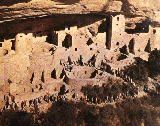


However, there is now evidence that suggests that other ancient migrations occurred across l the Pacific. Following sea currents and trade winds, people gradually crossed the Pacific from island to island, eventually reaching the South American Coast as early as 3,000 BC. The voyage across the Pacific to South America by adventurer-archaeologist Thor Heyerdahl in his polynesian built boat demonstrated this to be possible; Further evidence can be seen primarily in the presence in South America from an early date of agricultural products that are known to have originated in Southeast Asia-- notably chickens and cotton.
Also there is evidence that sailors from South China and Japan followed the Pacific rim coast of Asia to Alaska, and down the American coast to South America, as early as 300 BC. These sailors, following prevailing winds and currents, might have reached the American Coast by accident, during storms, or have come as traders, and probably as settlers. Evidence in the form of actual Japanese pottery found in Central and South America confirms that such contact occurred.
Thus we can see that not only was Columbus not the "discoverer" of America, Europeans were in fact relative late-comers to this continent. By the time Europeans arrived, North and South America were filled by a wide variety of ethnic groups, ranging from the hunter-gatherers of the central and northern plains, to the agriculturalists and city builders of the Mississippi valley and South America, and to the settled fisherman of the Pacific northwest.
 The indigenous peoples of North America as they were found by the first Europeans
can be grouped as either agriculturalists or hunter-gathers. The agricultural
peoples followed the same cyclical patterns in their religious and social structures
as did agricultural people in other parts of the world. Nature and human life
were seen as aspects of one spiritual whole, and the physical and spiritual
well-being of all was the result of communal effort.
The indigenous peoples of North America as they were found by the first Europeans
can be grouped as either agriculturalists or hunter-gathers. The agricultural
peoples followed the same cyclical patterns in their religious and social structures
as did agricultural people in other parts of the world. Nature and human life
were seen as aspects of one spiritual whole, and the physical and spiritual
well-being of all was the result of communal effort.
 However,hunter-gatherers, because of the very nature of their lives, depended
on the skill, bravery, and wisdom of individuals. Therefore the search for spiritual
truth was an individual quest. Rites of passage tend to be solitary experiences,
as opposed to the communal rites of agricultural peoples. At the center of most
hunter-gather religions is the idea that the hunted animal is a willing sacrifice,
but that there is need for rites of gratitude and propitiation to renew the
gift. Since hunter-gatherers must follow the herds, the life-style is nomadic.
Therefore these people own and leave behind fewer artifacts.
However,hunter-gatherers, because of the very nature of their lives, depended
on the skill, bravery, and wisdom of individuals. Therefore the search for spiritual
truth was an individual quest. Rites of passage tend to be solitary experiences,
as opposed to the communal rites of agricultural peoples. At the center of most
hunter-gather religions is the idea that the hunted animal is a willing sacrifice,
but that there is need for rites of gratitude and propitiation to renew the
gift. Since hunter-gatherers must follow the herds, the life-style is nomadic.
Therefore these people own and leave behind fewer artifacts.
The National Museum of the American Indian will show you traditional and modern work
This link will take you to A site where you can view the variety of Native American technologies and arts.
 The Iroquoian peoples who inhabited the woodlands of the Northeast
and upper Midwest were a loose confederation of tribes. The Iroquois were communal
farmers, who lived in extended family groups, sharing bark covered "long houses."
Corn and squash were important agricultural crops, and figure prominently in
Iroquois mythology and visual symbolism. However, designs tended to be highly
stylized. Secret societies were at the center of communal and religious life;
and the masks carved for ceremonials were believed to transform the wearer into
the healing or teaching spirit represented. Although copper was known, metals
were not common materials, nor were textiles. Birch bark,
quillwork, wood, and stone were commonly used. Some groups, such as the
Ojibwa of the Great Lakes region, wove mats and containers, using cedar fiber
and a warp weighted loom.
The Iroquoian peoples who inhabited the woodlands of the Northeast
and upper Midwest were a loose confederation of tribes. The Iroquois were communal
farmers, who lived in extended family groups, sharing bark covered "long houses."
Corn and squash were important agricultural crops, and figure prominently in
Iroquois mythology and visual symbolism. However, designs tended to be highly
stylized. Secret societies were at the center of communal and religious life;
and the masks carved for ceremonials were believed to transform the wearer into
the healing or teaching spirit represented. Although copper was known, metals
were not common materials, nor were textiles. Birch bark,
quillwork, wood, and stone were commonly used. Some groups, such as the
Ojibwa of the Great Lakes region, wove mats and containers, using cedar fiber
and a warp weighted loom.

|